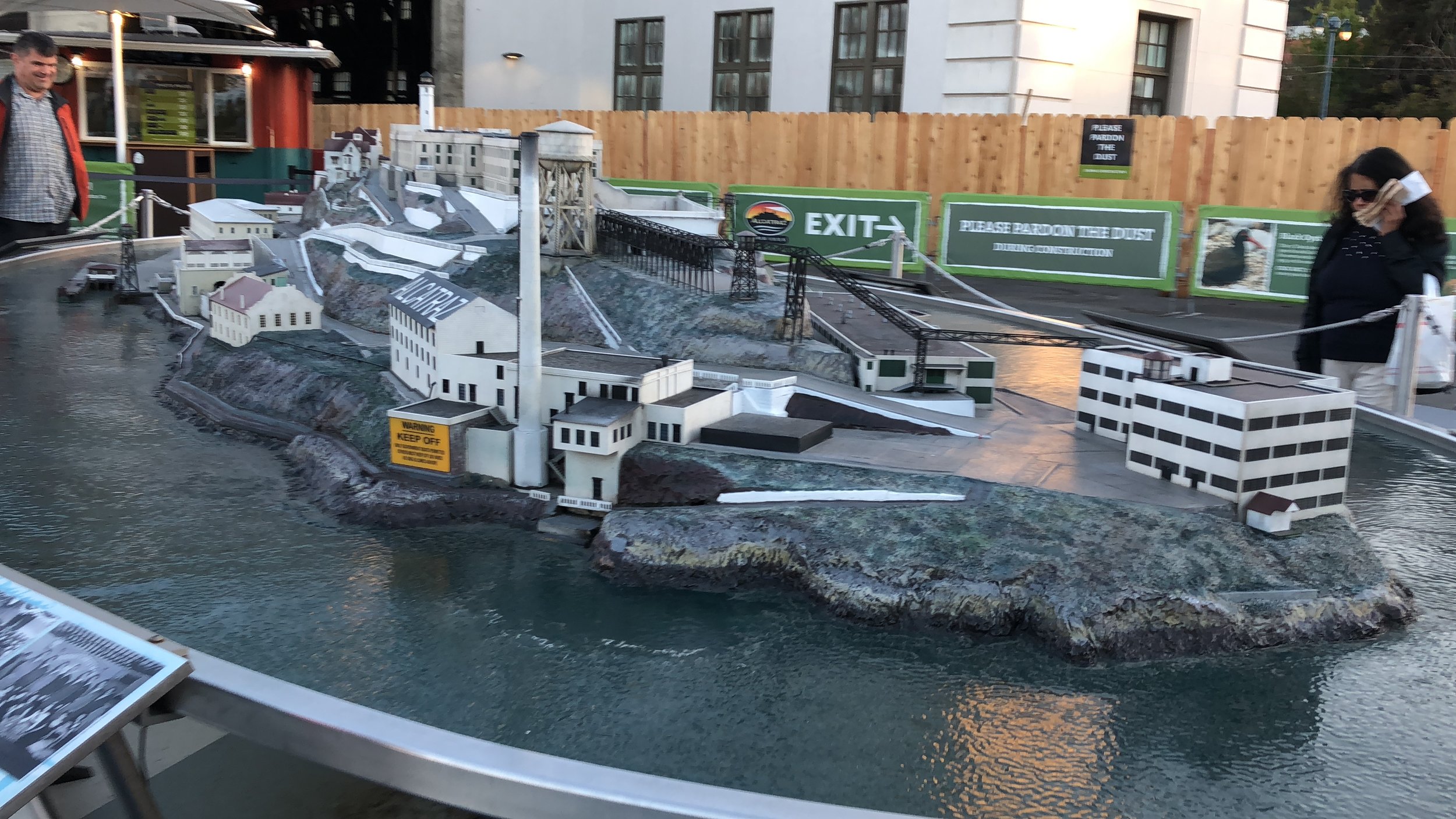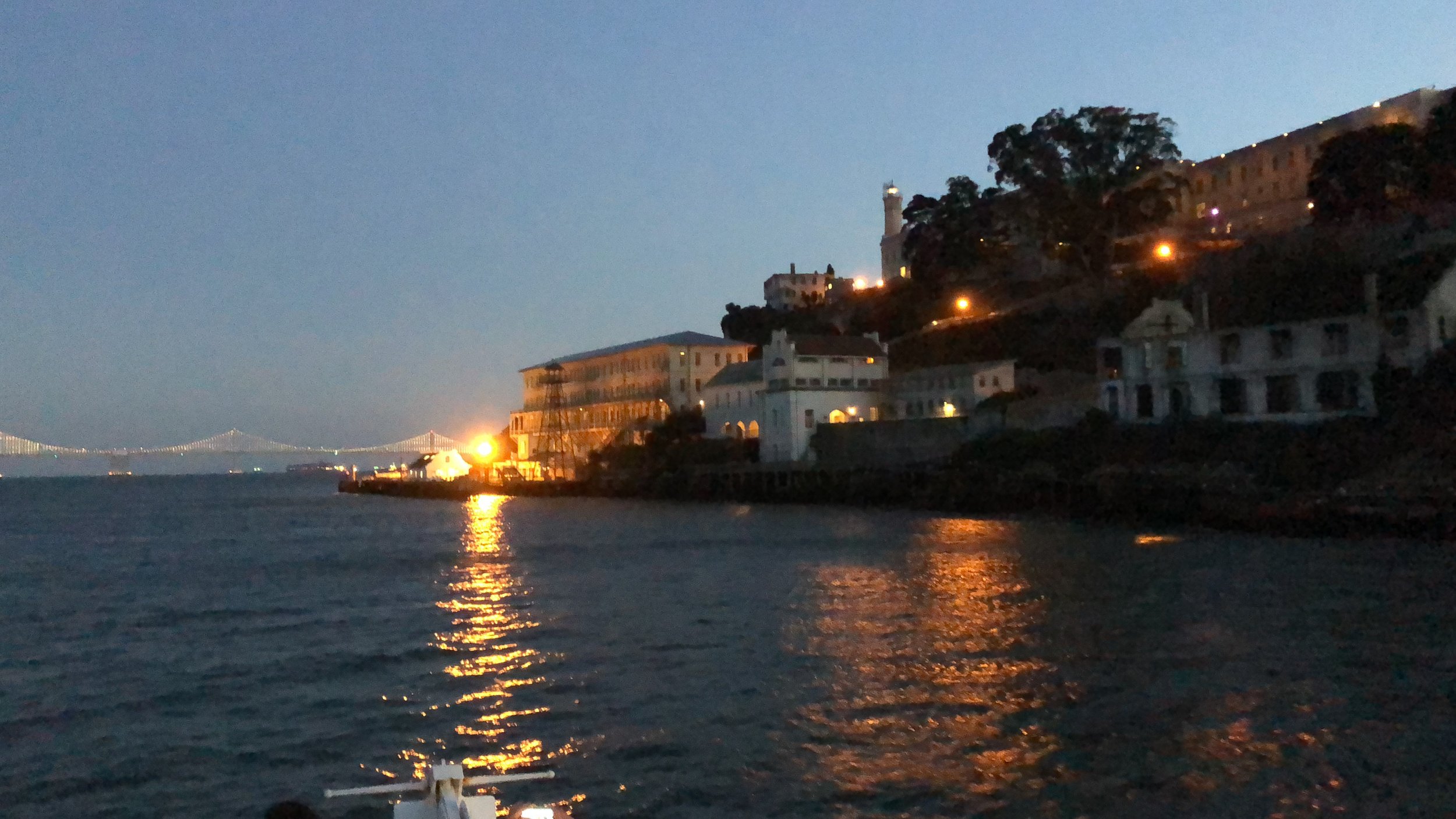A Somber Journey to the Rock. Alcatraz
In 2018 I was lucky enough to get to travel the Western Coast of the United States. I went from Portland, Oregon for a conference to the San Jose area of California for a convention. I decided to use my time to visit something that I had seen in movies such as All Dogs Go To Heaven 2 and heard about from friends and jokes all over my childhood: Alcatraz.
On the advice of a coworker, I opted for the night tour through Alcatraz Island Tickets. This tour is a 2 1/2 hour journey with special programs during it. It did not take long to see why it was recommended. When you arrive on the pier the mood is already shifting. You’re near to sunset and the gloom is starting to settle in. You are walked past a model of the island. I don’t know what I had in mind about a prison on an island, but this has already shattered my perceptions. There’s the main prison sure, but also housing for guards and families. There’s the docks for transport. There’s so much more already on the Rock than I knew about.
We have a ferry to catch and we’re docked next to a behemoth of a cruise ship. At this point in my life, I have never seen one in person. I had no idea the actual, sheer size these ships . Massive boats with so many floors raising out of the water, I’m reminded of skyscrapers with how I have to crane my next to see up. I can see the massive projection TV’s so clearly on the top deck; I can’t even imagine the size in person. They’re watching a soccer game, though I can’t make out the teams. We watch them leave port and follow slowly behind them as we start our journey. The sun is starting to set in the San Francisco Bay, and I stand on the bow in the whipping wind. I can hear gulls in the distance and my face is getting numb from the chills creeping in as night falls. I’m from the east coast, and let me say, I never could have imagined seeing the sun set over the ocean. From my vantage point, I am seeing a cruise ship chasing that sunset, all ablaze with every color in a rainbow, orange and red overpowering the rest.
This beauty is in contrast to the island in the darkness slowly approaching, covered in a dark silhouette that deepens while the sun continues it’s descent. I can still see the buildings and the rocky cliffs that helped prevent easy escapes. The guided tour is blaring on the speakers, hard for me to make out everything, but we are slowly circling the island to understand the size and the danger surrounding the prison. The means to cut them off from the rest of the word.
As we disembark, we are taken up a slow and long walk towards the main prison building. We pass quite a bit of history as we go. Everything keeps an eerie glow in the yellow lights struggling to lift the darkness. The guided tour has something for every step of the way. A sign alerts us to the mile and a half trip it takes to the dock and graffiti stands out from the 1970s Native American protests. Different stages in history creep their way in as you take in the atmosphere and reality of this rock. Cannons from the military fort, the lighthouse directed to be built by the first private owner, burned out buildings, and finally the cell block itself. Something about the night brings echoes that will haunt this trip. Many different people spent time here in incarceration; military prisoners, confederate soldiers, conscientious objectors, and federal prisoners. Many variations of the structures catered to them all.
My eyes were drawn to the shore and the sight of San Francisco ablaze. The skyline is a beacon of civilization just out of reach. For all the moving parts of the city, the sound is muted and not reaching me in the way I would have expected. A cold pressure of isolation settles around me to stay. Even with a bright night sky, full of stars and the wide expanse of space, it feels suffocating.
The tour through the building leads us passed check in, with cubbies for possessions, showers for intake and eventually we finally enter the first of the cell blocks. Three stories of cells, all identical, stacked on each other. Small rooms for all sizes of men. Everything blends together the longer you look. This exemplifies the quote from Inmate Jim Quillen: ‘You were a number, you weren’t a name; I wasn’t Jim Quillen. Hell, I was Number 586, and nobody wanted that.” Nothing but a number will separate you here.
The empty prison is chilling with history. The tour explains the locks and allows a demonstration. The coordination and grating noise of metal scraping and locking in place to lock and unlock every cell door at the same time. We shuffle along the cells, looking into each one, probably at a similar slow pace as those that have lost their hope and humanity here. I can’t keep shivers from erupting with each cell I look into. As we journey we get to areas of the older cells. This tour won’t be showing off the ‘Dungeon’ which was a converted basement. The location of the worst of the solitary confinement rooms but we can see the stairs in the ground that leads to it. It is lit and staring down it, you can feel pain and evil under the surface, trying to drag you down. Only the sound of your blood pumping in your ears, all your instincts are to run from this eldritch hole that holds your attention against your will.
We were allowed to enter some of the solitary cells to see how you can barely settle in them. Even with open doors, you feel smothered. Places like this will break any human before long. Frank Weatherman, the last prisoner to leave Alcatraz said “Alcatraz was no good for nobody.” You feel that too deep into your soul in this cell.
The tour continues and we see the guard offices, the bright lights a blinding contrast. The cafeteria that is a huge open and empty hall. The kitchen with its many knifes and tools is behind bars as well. Our journey takes us outside again for a bit. The only way some of us breath again. The city lights bring no comfort to me after the onslaught of the inside of this prison. History has settled on my spine and slumps me over. Every step to go back in and experience more is weighted but I need to see more and learn more.
We are taken to another cell block and we get to see the most famous of the cells. The ones of the most famous escapees. Frank Morris, John Anglin, and Clarence Angelin were able to make dummy heads from soap, cement, and paint and crawled out of their cells through vents in the back so they could scale to the roof and down a stove pipe. They made it to the shoreline and used a raft made from raincoats and were never seen again. The hole in the wall is still there. I can’t grasp how thin it is, I have no doubt, I could not fit, and see no way any grown man could have fit. A hole widened from spoons. The desperation and resilience it had to take for this escape attempt. While considered drowned, some people believe they lived out their lives in Mexico, their descendants still out there today.
1,575 prisoners were processed through the federal prison in 29 years of operation. You feel the weight of all of them as you visit, and those other prisoners before them. Alcatraz was a last stop for many. As a sign reminds us with a photo of prison intake: “You break the rules and you go to prison, break the prison rules and you go to Alcatraz.
While the tour finishes with other history, I cannot shake the prison from me. I watch the videos in a daze, I shop in the gift shop without thinking. The lives that were spent here in a federal prison now journey with me as I return to shore, my car, my rented rooms. I fall asleep to the final memory from the Native American protests which speaks for all the ghosts of the Rock: ‘We are still here.”









